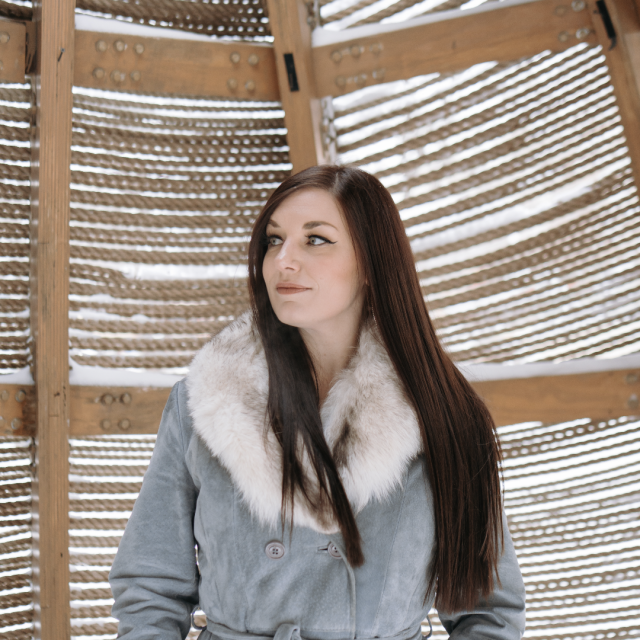June 2015
Twitter for Beginners Part 2: Tweeting, Discovering & Making Connections
- by Alyson Shane
Welcome back to my Twitter for Beginners series!
In the first post we discussed how Twitter works and became familiar with the terminology behind what we'll be discussing in this post, so let's get into the real nitty-gritty of starting to build a presence on a social network:
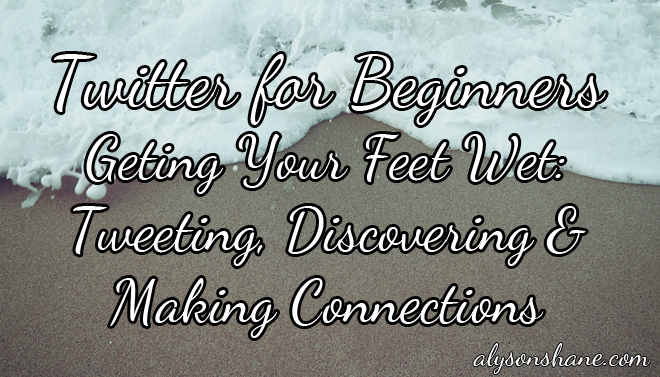
Your Account
Most people join Twitter for personal reasons: to connect with others, promote a business, make friends, etc. Some people join up and create parody accounts, which can revolve around themes or celebrities, but for most of us (and for the purpose of this series) let's just assume that you've signed up to Twitter because you're trying to connect with others and promote your business.
With these goals in mind, your profile should include a recent photo of you, as well as a short bio with links to any work or webpages that you want people to associate with your account.
Here's what my Twitter bio looks like, for example:
It's clear who I am, what I do, and gives potential followers an idea as to what they can expect if they follow me. I've also got a link to my website, because it's one of the places that I want my followers to visit. Try to avoid using too many @mentions or links in your Twitter bio, because it can look messy and disorganized. Try to be direct and use bit.ly to shorten your links if necessary.
Following & Followers
I've described in past posts as being at a party: there are lots of people around, everyone talking in smaller groups about topics that interest them. Like a big party, Twitter can see really daunting when you first show up: who do you talk to? How do you find like-minded people to interact with? What do you say?
Like a party, the easiest way to start talking to new people is to start with the people that you know: follow friends, colleagues, and people whose articles or posts you read online. Once you follow some people you know or are familiar with, take some time to go through their Follower and Following lists and check out the bios of the people they connect with (this is why bios are important).
Following someone doesn't automatically mean that they'll follow you back, but if people keep seeing you pop up in their feed as part of other conversations, or if you keep initiating conversations and participating with the same groups of people, it's likely that they'll start to follow you. The more interesting the content you share, the higher the likelihood that people will want to subscribe to your feed.
Once you've started following some people Twitter will be able to start sorting out your interests based on the people you've chosen, and will start making suggestions based on shared connections or interests. On Twitter's current desktop layout you can find this suggestion bar on the top right corner:
Remember: just because someone follows you doesn't mean that you have to follow them back if you don't want to. Twitter is about curating the kinds of conversations and information that you want to see, and just like how you can leave a conversation if it starts to get boring or uninteresting at a party, Twitter gives you the same option.
Try and be mindful of your Following to Follower ratio: this sounds frivolous, but if you're following a high number of people and have very few followers it looks desperate. When you're starting out, try to keep those numbers about even, but as you gain more followers try to keep your 'Following' number less than your 'Followers.' Public perception can go a long way online.
Tweeting & Connecting
Now that you've spent some time building a list of people to follow, it's time to start participating! While it might seem easier to start sending off 140-character thoughts or observations, the key to growing your Twitter community is engaging with others, especially at the start.
The best way to do this is to hit 'reply' to a Tweet that catches your eye. Maybe a friend shared a cool article, or made an observation you agree with. It's as easy as saying "yeah, that article about goats was really interesting!" or "I also enjoyed the fish tacos at that truck stand on Broadway" and you're off to the races.
If people on your feed are participating in a larger conversation their tweets will be connected by a thin line, like this:
If there are more than three messages in a conversation, Twitter will display a "view conversation" button, which will allow you to see what's been said previously, to give you some context of what's been said. In my experience, this is the thing that trips people up the most: they don't feel comfortable "entering" a conversation and adding their two cents.
Just start talking to people. If you see a conversation that you think is interesting, or is taking place between two people that you want to talk to, just @mention them and say your piece! Twitter is generally a pretty friendly place and nobody is going to judge you, think poorly of you, or (in most cases) be mean to you for simply joining a conversation.
Engaging with a variety of people increases your exposure. The people you're tweeting to might reply to you, which means your twitter handle will show up in their reply, or ReTweet (RT) or Quote you, which will share whatever you've just said with their network of followers. When other people see people they follow interacting with someone, they're more likely to start to engage with that person, too.
The key to tweeting is consistency: you need to be an active member in order for people to see your twitter handle on a regular enough basis that they want to start connecting with you. Try to tweet several times a day, at least, and be as varied with your content as possible: share news articles, photos, quotes, as well as reply and comment on things that others have shared.
Here are a few daily Twitter goals to help you grow:
- Tweet at least several times a day
- Have some variety in what you share: include links, photos, gifs, RTs and Quotes whenever possible.
- Follow at least one new person a day
- Participate in a conversation relevant to your niche with a trending hashtag (#)
Muting & Blocking
'Muting' someone on Twitter means that a specific Twitter user's tweets won't show up in your timeline. The muted user can still see your content, favourite it, and send you mentions or @replies (though you won't receive a "push" notification when they do.) You can mute someone without unfollowing them and without notifying them, which can go a long way if a colleague isn't that interesting or you don't want to offend a friend by unsubscribing to their slew of hockey-related tweets.
Blocking someone takes things to the next level. If someone starts harassing you, bothering you, or you simply don't want to interact with them anymore, you have the option to block that account from seeing your Tweets, and you from seeing theirs.
If you block someone they can visit your profile page and see that they've been blocked, whereas if you mute someone they will assume that it's business as usual because nothing will appear to have changed on their end. Try to be mindful of who you block or mute, but at the same time don't put up with any abuse - if you feel like someone is harassing you, or posting inappropriate content, report them to Twitter and block them immediately.
No amount of social clout is worth staying connected to a bully or someone who makes you feel uncomfortable or unsafe online
Tailored Trends
If you're using Twitter on your desktop you might have noticed a tab to the left of your feed called 'Trends.' This can be a really powerful tool for finding share-able content and keeping on top of conversations which are relevant to your interests.
By clicking on the "Change" button inside the Trends box you can begin tailoring what you see to your location (in my case it's Winnipeg) or larger, more popular trends on across Twitter's communities. By following and tweeting about popular topics within your network or niche you increase the likelihood that someone else with the same interests will see it and add you to their network.
Understanding what people are talking about you can make sure that you're able to add your voice to the conversation and be heard; you'll know which hashtags to use and which topics they refer to, so your tweets can be consistent and clear.
Now you're tweeting - congrats!
You're started getting your feet wet with Twitter; you're tweeting a few times a day, following new people, and starting to become more comfortable with a 140 character limit.
That's great, but there's still lots to discuss:
How do you define your 'voice' on Twitter?
What the heck is a 'Twitter Chat"?
Should you use third-party applications? Which ones?
Is there a benefit to using Lists?
and more, which will be covered in the final instalment of my Twitter for Beginners series:

This post is part of the three part series on Twitter for Beginners. Make sure to read part one, part three, and the extra credit as well! The entire series can be found here.
Twitter for Beginners Part 1: Getting Started
- by Alyson Shane
I get asked a lot about my preference of social media platform; namely, which one do I feel is most effective for getting your voice out there and starting to build an audience for yourself.
My favourite, hands down, is Twitter. I love Twitter.
The problem is, I often find that I'm the only one. When I tell people that I love Twitter above all the rest their eyes usually get big and they something like "I don't get Twitter" or "Twitter is too hard!"
So with that in mind, I'm going to be doing a series of Twitter for Beginners posts about this topic: we'll focus not just on how to use this important tool, but also why we should be using it, and best practices for first-time tweeters.
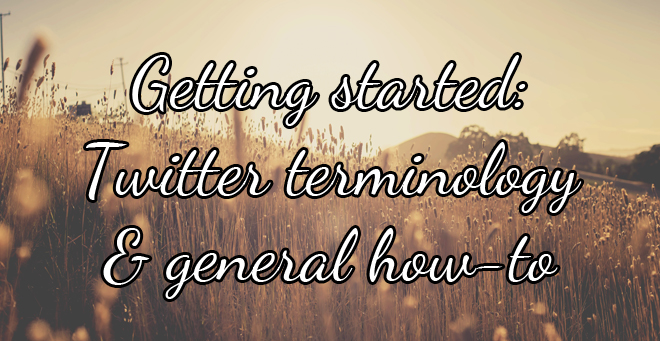
Twitter Terminology
Twitter has a lot of terminology and rules specific to its platform, which is one of the main reasons that so many people steer clear of using it (or don't use it effectively). Here are the basics:
Tweet: a tweet (like the bird logo, get it?) is the body of your message. It can be text, numbers, or characters but it has to remain under 140 characters in total. This is what a lot of people struggle with, because it can be tricky to boil your thoughts down to such a narrow limit.
This, however, is what makes Twitter such a valuable tool. Because you can't ramble on forever and are forced to be concise, the conversations on Twitter flow a lot more quickly and the focus is more on sharing a link to a separate, longer article or thought piece than about making a single statement.
Twitter handle: this is your username on Twitter. It refers to the name that you've chosen and the @symbol that precedes it. For example, mine is @alysonshane.
The @ symbol before your name is how Twitter recognizes that the name or words of your handle are associated with your account.
Mention (@mention): a mention is when you post a public message on Twitter and include someone's Twitter handle in the body of your tweet. When you @mention someone, they receive a notification and (in theory) will begin participating in the discussion.
So if I wanted to tweet at you I would type "hey @yourtwittername, hope you have a great week!" and Twitter would know that because I typed a @ followed by a user name, then I'm tweeting at someone, which is the Twitter equivalent of initiating a conversation with them.
Best practice here is to only @mention people who you know, or who are directly related to what you're tweeting about (eg: article authors, people involved with an event, etc). Tweeting randomly at people is a Twitter faux-pas, and should be avoided (we'll go into more of this later).
Twitter Feed: Your 'feed' is the aggregate of posts from people that you follow, which is displayed on your home page. By paying attention to your feed you can see up-to-date posts in chronological order, which helps you keep track of who said what and when.
ReTweet (RT): A ReTweet is creating a carbon copy of someone else's tweet, which gets shared on your own timeline. This serves as an easy way of sharing links, content, or otherwise showing that you agree with whatever is in the body of the tweet.
Twitter also allows a "Quote" option for ReTweets, which allows you to write your own tweet while including a photo (and link to) the original tweet in your post.
For example, here is a quoted retweet of mine that includes my own comments as well:
Hashtags (#): A hashtag (or # symbol) is a tool for participating in a conversation. A hashtag instantly connects a social media post to a group of others about the same topic, and connects the person sharing it (you) with other people talking about the same topic in real-time.
Brands, companies and individuals all use hashtags as a way of talking to a larger group of people, or of promoting themselves. For example, the sports equipment company Nike frequently includes #justdoit in their tweets. "Just Do It" is Nike's slogan, and helps people understand that what they are sharing is part of a larger narrative.
For more detailed info on hashtags and how to use them, check out my longer, more detailed post on it here.
Direct Message (DM): A Direct Message is a 140 character private message between two people who follow each other.
Most people believe that two people need to be following each other in order to message privately, but there's a feature under Settings > Security & Privacy called "Receive Direct Messages from anyone" which, if selected, allows you to (big surprise) receive messages from any Twitter user even if you don't follow them.
Keep in mind that while still technically "private" a Direct Message can still be saved as a screenshot and shared elsewhere, so be wary of what you DM to your fellow Twitter users. Don't become the next Anthony Weiner!
So we've gone over the basics and you're ready to sign up and start tweeting!
But what do you say?
Who do you say it to?
How do you attract new followers
What can you do to help them find you?
How do you use all of the tools that we've just discussed effectively?
We'll be going over all of that in greater detail in the second installment of this series:
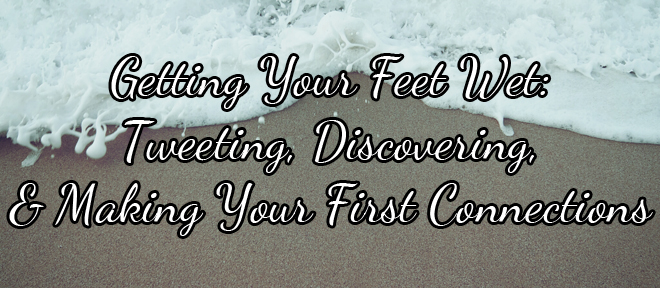
This post is part of the three part series on Twitter for Beginners. Make sure to read part two, part three, and the extra credit as well! The entire series can be found here.
Crowdfunding Crash Course: Stacy Kelly - SolarPuff: A Unique Little Solar Light
- by Alyson Shane
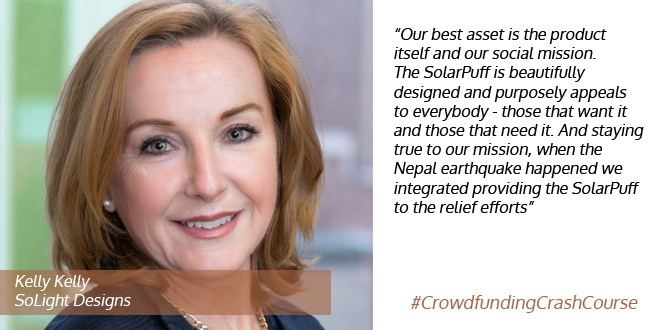
Stacy Kelly is a Co-Founder and Chief Operating Officer of Solight Design. She has the dual role of being responsible for managing the manufacturing and shipment of our products while also developing strategic business relationships, and used Kickstarter to fund the SolarPuff, an inflatable solar-powered lamp.
Can you briefly describe the SoLight SolarPuff?
SolarPuff: A Unique Little Solar Light. It’s a patent pending light-weight solar powered lantern that packs flat and easily pops open. It is made with recyclable material, it is water resistant and it floats. Great for camping, boating and outdoors, as well as disaster relief, emergency lighting and ambiance.
Why did you feel that the crowdfunding model was the best way to promote the product?
We feel that the crowdfunding model provides the opportunity to test your product demand with a large group of early adopters who at the same time will (potentially) provide the funding to get your idea to market. It was never really a question as to whether or not we would go the way of crowdfunding, it was just a matter of when.
Why and how did you choose Kickstarter over other crowdfunding options available?
We chose Kickstarter over the other platforms mostly because of word of mouth. We know a few other people who had run successful campaigns on Kickstarter and due to their experiences we felt more comfortable following their lead. In addition, the Kickstarter platform is extremely user friendly and they make it as simple as possible to get your campaign up and running. They also have a huge community and market aggressively to the community on your behalf and to keep them engaged.
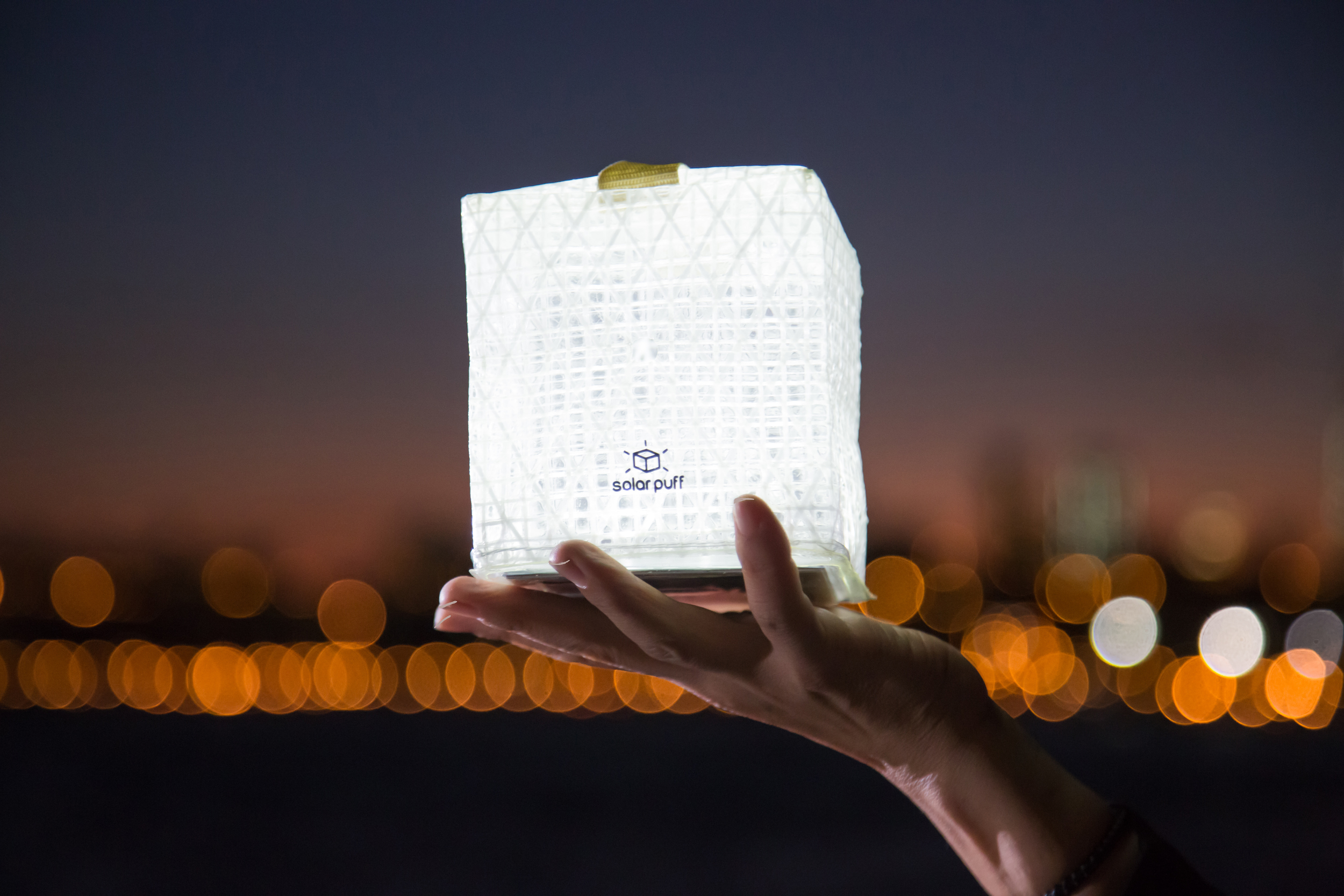
How big was your budget before you launched your crowdfunding campaign?
Budget??? What budget? Seriously, we were fortunate to know some very generous people such as Frederic King, our videographer, who worked pro bono. We used our own social and email networks to get to our initial goal of $25,000. We spent about $200 on Facebook advertising and another $200 with crowdfunding networks. We were advised by other successful campaigners to avoid buying into all the PR companies that approach you, unless somebody you know recommends them.
How far along was your project before you felt ready to launch a crowdfunding campaign? In hindsight, would you have preferred to be farther along, or to have crowdfunded earlier?
The SolarPuff, our first product has been on the drawing board for a few years with patents pending. We launched Solight Design about 18 months ago. We started manufacturing the SolarPuff in Q3, 2014 and completed our website in Dec, 2014 with a soft launch in January. We sold over 1000 units in 2 months. We presented to MoMA in Q3 and got positive feedback and knew now was the time to take it to the public. The fastest and most economical way was through Kickstarter, besides, we needed funding to purchase more inventory. I think we launched at just the right time in our business cycle.
Can you explain how you prepared for and managed your campaign?
We prepared by organizing our email lists and upping our social media outreach. We worked with our videographer and edited until we were happy with it. We fine tuned our “story” over and over again. A big part was coming up with the reward packages to make them authentic to our mission and to promote the product. We had given ourselves an April 22nd campaign launch date and spent the prior 2 months working on all the pieces.
What tools did you use to market your campaign? Do you feel like you did so successfully, and if not, what could you have done differently?
Our marketing campaign was not extravagant. We purchased advertising on Facebook to “boost” our posts, we paid two crowdfunding outreach companies for PR, one of which also included us in their web blog. The best and biggest boost to our campaign came from Kickstarter themselves (unpaid). Once they promoted us as “Projects We Love”, it was a game changer. In 24 hours we raised over $125K. That really put us on the map and after that a number of media outlets contacted us and helped to get us to $447K. “It take a village.”
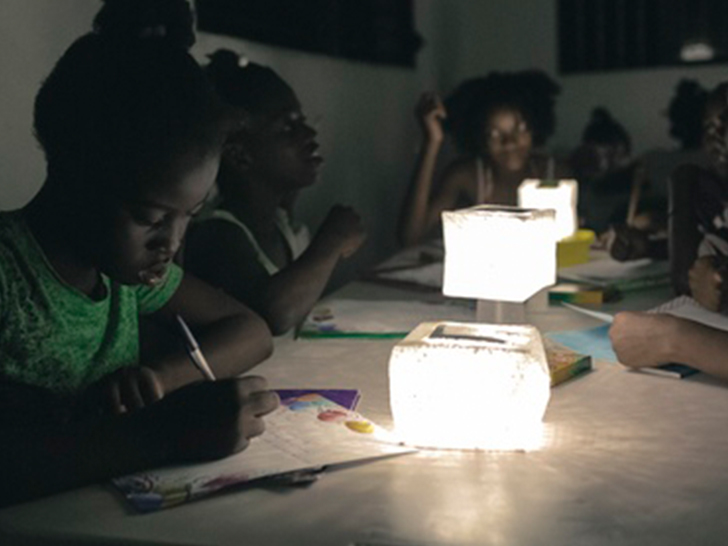
In retrospect what were your best assets for running this successful campaign? On the other hand, what would you do differently?
Our best asset is the product itself and our social mission. The SolarPuff is beautifully designed and purposely appeals to everybody - those that want it and those that need it. And staying true to our mission, when the Nepal earthquake happened we integrated providing the SolarPuff to the relief efforts. I think many people connected with our appeal and were happy to be able to do something to help the Nepali people.
Hindsight is 20/20 of course. What we’d do differently is plan for an overwhelming success and have more product on hand, however it is a catch 22. We went on Kickstarter to get funding for more inventory and now we need even more inventory to fulfill our orders.
We would have been more saavy about “stretch goals”. We didn’t quite understand the value and importance of them to the backers. We really didn’t offer any stretch goals except seeds which were a bust (a story for another time).
What was your biggest challenge during your campaign?
The biggest challenge is staying organized. We had a lot of people asking a lot of questions and getting back to all of them (and we did) was very time consuming. We also had a lot of people making special requests with regard to their pledges (send two to Nepal instead of buy one, give one; ship to a vacation home, wanting to mix and match reward tiers, etc). You need to keep notes on each of these and that too requires time and organization. Now the hardest part is collecting each backers (close to 7000) shipping info and confirming their pledges is another organizational challenge.
So in closing, I will tell you that it was a wonderful, exciting and validating experience. Every hour brought us to a new level. Every backer validated that the SolarPuff is a great product. The comments from most of our backers were so supportive that it would make the most jaded person optimistic.
I think every person with a good product and a good idea should go the crowdfunding route. We were very lucky to have gone wildly over our goal. As the philosopher Seneca, said, “Luck is what happens when preparation meets opportunity.”
This post is part of the #CrowdfundingCrashCourse series. You can find the entire series of interviews and summary posts here.
Supporting My Community: MBCouldBe and Pride 2015
- by Alyson Shane
Somehow on a random Wednesday I found myself wide awake at 5am. As I was lying in bed cuddling Toulouse and listening to John snore softly (it's adorable, seriously) I started thinking about community, how important it is to make the time to make your values known, and to support causes that you believe in.
This past weekend I volunteered at #MBCouldBe, a policy summit put on by Manitoba Forward. I volunteered with John and Luke Jacob, and we spent the day listening to various speakers and panel discussions and tweeting from the Manitoba Forward twitter account (as well as our own, of course).
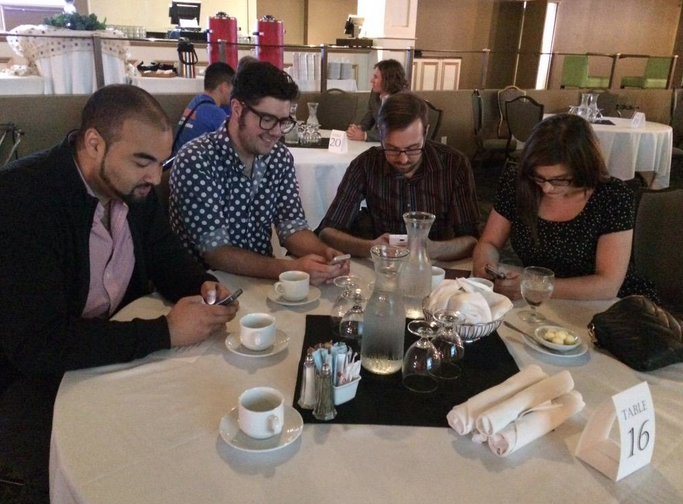
(All of us setting up for a busy day of Tweeting.)
When I arrived I wasn't sure to expect; what sorts of people would be there? What would their views be? Was I just walking into a giant, one-sided political discussion?
What I found surprised me: I met a diverse group of individuals and speakers who were all interested in actively discussing ("actively" is putting it lightly in some cases) the ways in which Manitoba could work towards being a more successful and vibrant province. I was impressed at the variety of speakers at the event: some were obviously very centre-right, some much more liberal in their views, and the discussion that took place was positive and informative.
What impressed me the most, though, was the sheer amount of people that came out on a warm June afternoon on a Saturday, while events like Jazz Fest were going on and patios were abound, to sit in an event centre and discuss Manitoba's future.
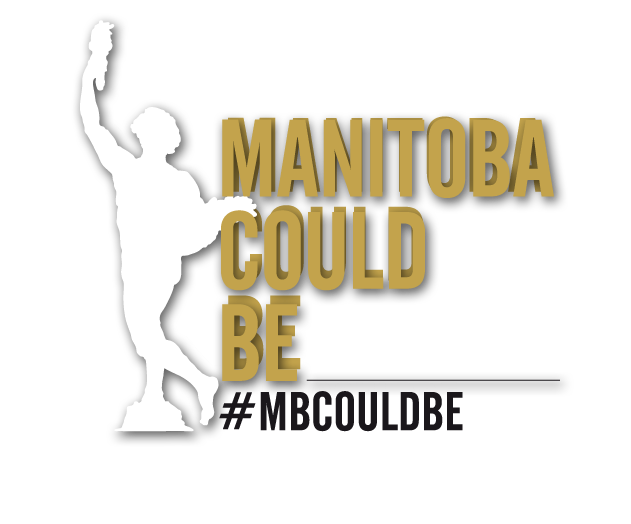
This was important to me for several reasons, the largest of which is that as a Manitoban I was raised with a very healthy sense of self-deprecation, which I've written about before. Manitobans can be snarky and we can be cynical, especially about our own hometown and our province. We're raised with the belief that Winnipeg, and Manitoba on a larger scale, simply isn't worth the energy. Why put time into improving our local economy or starting a small business here when we can just run off to Toronto, Montreal, or Vancouver?
I used to have that mindset. Not so long ago I was dead-set on moving to Toronto, where I have some family. I was going to leave Winnipeg in my dust and make it big in Ontario. Then something changed: I took a class at the University of Winnipeg called (appropriately enough) "The History of Winnipeg" which completely changed my views.
When I started spending time getting to know the complexities of the city and the province where I grew up, I started to develop a deeper understanding of why our issues were unique, and for the rich, beautiful history we have here and the strong, creative, interesting people decide to spend their lives here. I fell head-over-heels with Winnipeg, and decided that I wanted to stay and invest my time, my business and my life to helping make it a better place.
Many Manitobans still have that negative mindset, unfortunately, but among the people that I spoke to and who participated at #MBCouldBe I didn't hear a single dissenting voice. Instead I heard a ton of local pride, and even when we discussed ways in which we could be better, it was always with hope and with a fierce sense of dedication to making Manitoba an even better place to work and to live.
--
Another way I experienced local pride this weekend was the following day, when I marched in the 2015 Pride Parade. New Media Manitoba sponsored a banner in the Pride Parade and I tweeted about it and marched with my friends in support of the LGBT community.
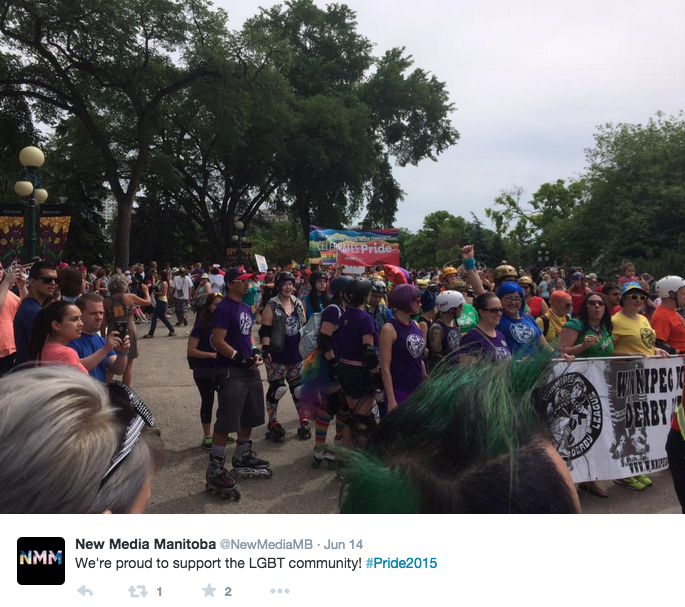
There were over a thousand people who showed up in costume and with banners and floats, and the outpouring of love and support for the LGBT community is what makes Pride one of my favourite annual events - I've been going since I was allowed to start taking the bus downtown from the suburbs where I grew up.
Someone once said to me "we march in the Pride Parade so that one day we don't need one." As in, by raising awareness and support got the LGBT community with the parade, eventually they hope that society will become accepting of those individuals to the point where a parade is no longer necessary. The whole point of the annual Pride week is to mobilize support for the LGBT community and to show people that there are people who support the rights and freedoms of others to express themselves and to be who they are, regardless of what (if any) gender they identify with.
--
This morning, while watching the dawn creep into my bedroom it struck me that half of showing your support is simply showing up. It's very easy to play Armchair Activist (and we all do, to some extent) but by taking the time out of our daily lives to physically show up and show support for our local communities -be they political, social, sexual, whatever- we help make the world a better place because we add our voices and our bodies to causes that matter to us.
I spent my past weekend, almost in it's entirety, lending my time and my energy to causes that I believe in and it felt amazing. It was a terrific reminder that, really, all we need to do to start making our communities a better place is show up and get involved.
Have you attended any local events in your community lately? What were they for? I'd love to hear about them!
Crowdfunding Crash Course: Tamar Swartz - Journey to Surrender
- by Alyson Shane
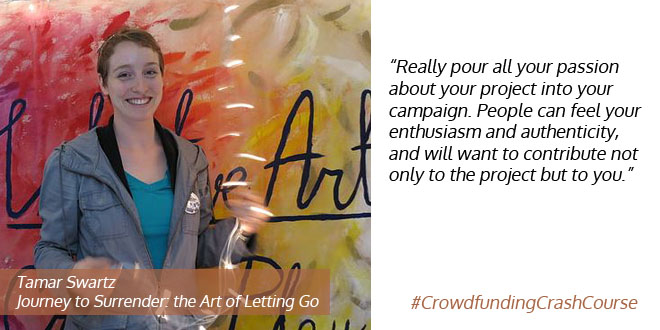
Tamar Swartz is a Canadian mixed media visual artist following her creative intuition in painting, drawing and collage. She used Indiegogo to fund her art project Journey to Surrender: The Art of Letting Go.
Can you briefly describe Journey to Surrender: The Art of Letting Go?
Journey to Surrender: The Art of Letting Go is a creative project currently being developed during a 6 month artist residency in Budapest, Hungary. It’s about following your own creative intuition and allowing a piece of art to emerge and breathe, like any living organism would. It’s about trusting yourself and embracing the creative process while releasing conceptual and intellectual approaches to art making.
Journey to Surrender is a three-part project. Part one is my own mixed media visual art practice and walking the pathways of Creative Surrender. Part two is collaborating with other artists to find Creative Surrender together. Part three is facilitating workshops for local participants to experience this form of expressive visual art making.
Once the project is complete, my experience will be integrated into the Intuitive Art workshops that I facilitate. You can read more here.
Why did you feel that the crowdfunding model was the best way to promote the project?
A large part of the project is to have other people involved and engaging with expressive mixed media visual art and Creative Surrender. Crowdfunding seemed like an obvious choice to spread the word and build momentum about realizing Journey to Surrender. Additionally, once the artist residency is completed, I will be integrating what I have learned into my Intuitive Art workshop facilitation.
Why and how did you choose Indiegogo over other crowdfunding options available?
I looked at Kickstarter as an option, but wasn’t completely sure about the all/nothing model for Journey to Surrender: It seemed like a big leap of faith.
I was also under the impression that my project would have to first be approved by Kickstarter before the campaign launches, a process that takes time. I was on a short timeline and ready to start the campaign. Indiegogo has a really easy to navigate platform and their customer service is very helpful.
How big was your budget before you launched your crowdfunding campaign?
I’m not 100% sure how to answer this question…are you asking about the financial resources that were needed to make Journey to Surrender happen, that I had before starting my campaign? If so, $0. Or, are you asking about how much money I spent building/marketing my campaign? $0 but a lot of time, energy and creativity.
How far along was your project before you felt ready to launch a crowdfunding campaign? In hindsight, would you have preferred to be farther along, or to have crowdfunded earlier?
Journey to Surrender did not officially start until I landed in Budapest, so my Indiegogo campaign was a “pre-project” campaign. Within the week that I received confirmation that my residency application was accepted, I started building my campaign. I drew on my Intuitive Art facilitating experience (2 years) and all my art from my own creative practice. It was now-or-never for me.
Can you explain how you prepared for and managed your campaign?
It took about 2 weeks building my campaign. I spent a lot of time making sure it clearly said what I wanted, adding photos that represented Intuitive Art, and designing perks at different price levels. I asked a few close friends to check it before I launched and got some valuable feedback. Also, these friends were “cheerleaders” throughout the campaign and helped me spread the word about Journey to Surrender.
I also made a timeline of my campaign and set up a schedule of when to send out invites and reminders to participate in the campaign. I was successful in not spamming people. I also made funding goal targets, which turned out to be flexible.
What tools did you use to market your campaign? Do you feel like you did so successfully, and if not, what could you have done differently?
I mostly used social media and personal social networks to market my campaign. I posted on my Facebook, Twitter and Instagram accounts. Hashtag everything!
I also sent a lot of personal emails and Facebook messages to friends, family and acquaintances who I thought would be interested in knowing about my project. I received a lot of positive feedback.
Out of all the generous contributions, only 2 were received from complete strangers. Next time I would like to know how to crack that line between friends/family/acquaintances and complete strangers.
In retrospect what were your best assets for running this successful campaign? On the other hand, what would you do differently?
My best asset for this campaign was my enthusiasm and a really compelling combination of a written pitch, images of my art and perks that were appealing. I received a lot of positive support from friends and family!
I think that having a campaign video could be fun for next time. But, I realized that for Journey to Surrender it wasn’t completely necessary.
What was your biggest challenge during your campaign?
Holding faith that it would be successful. There are days where no one contributes or seems to be talking about it, which is feels like nothing is happening. But, even on those days I had to remind myself that contributions come in waves. It was really incredible how in the last 42 hours people really rallied and funds were literally flowing in. Journey to Surrender ended up being 135% funded! There’s something about the pressure of the campaign ending that motivates people to contribute.
What’s the most valuable advice you could share with aspiring crowdfunders?
Really pour all your passion about your project into your campaign. People can feel your enthusiasm and authenticity, and will want to contribute not only to the project but to you. Be open to surprises! Sometimes the people who you expect to contribute don’t, and the people who weren’t even on your radar do. Don’t take anything personally and always always ALWAYS practice gratitude. Even the smallest contribution is important. Also, be mindful that sometimes contributions are not monetary.
This post is part of the #CrowdfundingCrashCourse series. You can find the entire series of interviews and summary posts here.
The Case for Knowledge Sharing
- by Alyson Shane
The other week I attended the Winnipeg Game Jam, a weekend-long event where local developers, artists and the like got together to spend a furious weekend creating an indie game together. Mostly they worked in teams, but there were also a lot of people who walked around and offered to help other teams when they had some downtime, which I thought was really interesting.
The more I thought about it, the more I felt that what I saw at the game jam was representative of the type of positive, collaborative spirit that I've discovered in Winnipeg. I frequently get the sense that "we're all in this together," and that we're all working towards common, shared goals of lifting each other up and working together towards success.

In the short time I've been involved in our community I've learned a deep appreciation for sharing knowledge and collaboration through attending events like the Winnipeg Game Jam, and with that in mind I'd like to discuss why I think sharing knowledge, experiences and resources is something that we should all strive to do.
Why should we share what we know?
First things first: I wouldn't be doing what I do without the guidance, advice and knowledge of dozens of people who happily shared it with me - over a coffee, over a glass of wine, whatever. The fact that I've been able to meet tons of helpful, knowledgeable people who have been giving with their time has allowed me to grow my business and, in turn, start helping others grow theirs as well.
As a result of these experiences and the help I've had, I've come to believe that knowledge is a powerful tool to have in your arsenal, and considering information economy in which we live, I'd argue that knowledge is more powerful when you share it than when you keep it to yourself.
Here are a few reasons why I think it's good practice to share what you know:
Sharing knowledge makes you a thought leader & an expert in your field
This is something that I've had to repeat to several of my clients who have been wary of posting blog content or articles which they fear will give their competition an advantage. Spoiler alert! Anything you know can be found with a quick Google search... but that isn't the point. By being open and giving with your knowledge people will have a greater respect for you - not just because you know what you know, but that you have the ability to articulate it and the desire to share it with others and help them.
Let's use Paul Graham as an example. For those of you not familiar with his work, Paul Graham is a programmer, venture capitalist and essayist (whose essays you should definitely read) who developed Viaweb, the first application service provider (ASP) which eventually got bought out by Yahoo! and allowed Paul to go on to found YCombinator, one of the most well-known and respected seed funds in the world.
Do thousands of entrepreneurs and businesspeople who apply to YCombinator think less of Paul Graham because he gives away his knowledge for free in essays and in meetings? Of course not. They eat up his words and try to apply his insight to their own lives and challenges, and when he speaks, they listen.
This is because people don't come to you just for your knowledge; they come to you for the judgments that you make based on that knowledge.
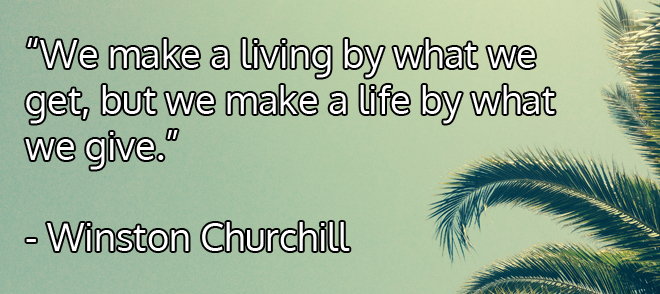
Sharing knowledge builds relationships
I've had a variety of coffees and hang-outs with local content-marketing types like myself where we've chatted about our various projects, struggles we're having, and how we can provide better service for our clients. I've received advice and doled it out in kind - but what's important in those interactions is that we've moved from being internet strangers to real-life acquaintances (in fact, if we're lucky maybe we can even level up to being friends, who knows?)
Everything in life is about who you know. This applies to both online and offline relationships, and if you position yourself as someone who isn't willing to take the time to help other people then it's very likely that, in turn, people won't take the time to help you.
Especially in this digital age, the more people you know and develop healthy, positive relationships with the better off you'll be. Gone are the days of lone-wolfing it and trying to alienate everyone for fear that they might use your knowledge against you; by surrounding yourself with a vibrant community and constantly working at growing your network by sharing what you know and helping one another you set yourself (and everyone you help!) up for future success.
Sharing knowledge can change the world
By working together and sharing ideas, information and experience we can make really great things happen.
Case in point: open source software. The PHP language, which powers about 60% of websites, or Wordpress, which powers about 30% are both, open-source. Huge, world-changing websites like Facebook wouldn't exist without open-source tools like PHP and MySQL. Linux, which is the open source code behind Android, powers most of the phones on the market today, and it's creator, Linus Tovald also created an open source tool called Git, which has changed the way that millions of developers work and build collaboratively.
Open source is my favourite example of the benefits of knowledge-sharing and collaboration because it hasn't resulted in mass unemployment or people losing their job prospects because they taught someone else what they knew. In fact, it's only strengthened the developer community and allowed them to make amazing things together.
Why does this matter?
It matters because the world is rapidly changing, and having a mindset of scarcity is something that, collectively, we're moving away from. People are starting to realize that there is in fact room for everyone to be successful, and by lifting each other up we all benefit from it.
I've seen it firsthand at events like the Winnipeg Game Jam, and at local events held by groups like RampUp Manitoba, Skullspace, New Media Manitoba and AssentWorks (to use a few local examples). By sharing knowledge and resources our communities are growing and flourishing, and by helping other people we become more powerful, ourselves. Giving away knowledge doesn't diminish how much of it you have, and we all benefit from a community of people (in whatever profession) who are willing to contribute and make that community the best that it can be.
Why you should share:
Know what the best part in all of this is? Helping people feels good. The feeling that you get when you do someone a favour, introduce them to someone who helps launch their career, or even give them a hand in navigating a sticky situation is so rewarding, and that person will remember you for what you did for them and will be more than willing to help you in the future.
Sure, there are exceptions to this rule -some people are just jerks- but going around assuming that everyone is trying to screw you over or waste your time is a pretty sad and lonely way to go through life, and pretty much guarantees that nobody will want to work with you once your true colours show through (and believe me, they always do).
The world is changing. Like I said at the beginning of this post: we live in an information economy, and knowledge is power - especially when you have a lot of it and share it readily. When you take the time to share what you know with people it guarantees that you will be successful in your endeavours because people will want to work with you and help you. It also guarantees that you will be more respected by your peers, more well-liked, and that you'll be a happier person overall because (and this is really the most important part, at the end of the day.)
What is the most important piece of knowledge that someone had given you? I'd love to know!
The Power of the Hashtag
- by Alyson Shane
In the last few years the use of the "hashtag" (the # symbol - previously called the 'Pound Sign' if you're a fossil like me and used a push-tone phone growing up) has exploded in popularity. Unless you live under a rock you've likely been bombarded with the hashtag symbol everywhere - on commercials, billboards, on social media, on clothes... these days the "hashtag" is one of the most pervasive and powerful symbols of our digital age.
Despite seeing hashtags everywhere, most people don't understand their importance or how to harness their power to help them convey their message across social media platforms. A simple hashtag can improve your reach, drive brand recognition, and easily engage in large-scale conversations online.

#Why?
If you're a business owner or someone hoping to expand their social media influence, a hashtag should be an important part of your social media strategy. This is because a fitting hashtag can help drive brand recognition, drive customer loyalty, and help spread the word about your idea or product.
A hashtag instantly connects a social media post to a group of others about the same topic, and connects the person sharing it (you) with other people talking about the same topic in real-time.
What this means is that you can include a simple hashtag in your social media post and immediately have it seen by anyone else looking for that hashtag. Here's an example using Twitter:
Above is a tweet that I just created which includes the #SocialMedia hashtag. When I tweet something that includes a hashtag, the hashtag works like a link which allows people to click on it and find other tweets relating to the same subject.
When I click through on the # link Twitter takes me to a page filled with other tweets which include a "#SocialMedia" tag. The "live" feed (people using it in real-time) looks like this:
As we can see, my #SocialMedia hashtag allows me to connect with other people who are tweeting about the same subject, and for others to find my tweet as well. Twitter also offers search options to refine what you want to see from that topic.
Hashtags first started to become commonplace on Twitter as a way to link ideas and conversations in the way that I just described, but other social platforms like Facebook and Instagram have also adopted using them as well.
#How
Even if you know why a hashtag is important, it isn't going to do you much good if you don't know how to use it effectively. In fact, when misused you can actually drive people away from your message because too many hashtags feels spammy (more on that in a second.)
Here's are some ground rules for making sure you're using hashtags to their full usefulness:
- Use the hashtag (#) before relevant words or phrases to categorize posts and help them show up in a search (like in my previous example).
- A hashtag can be included anywhere in the message - they don't have to be stuck at the beginning or at the end if you can work them into the body of your message.
- A hashtag won't appear in a search if your profiles are protected or private.
#Etiquette
Don't #spam #with #hashtags.
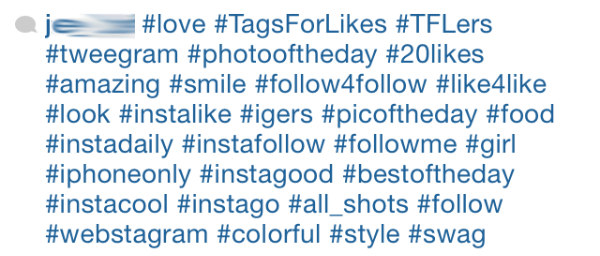
(via Google. I have no idea who this poor soul is)
Don't over-tag a single post. Twitter's best practices recommend no more than two per tweet, and in addition to being visually unappealing it also dilutes your message. Using too many hashtags dilutes the meaning of your message because you're trying to appeal to too many ideas at once.
An exception to this rule is Instagram, in which photos with at least eleven (yeah, 11!) hashtags get the most interaction. This is because Instagram doesn't have a character limit for captions on their photos, and because hashtags are the easiest way for its communities to connect with one another
The trick do doing this effectively, however, isn't to include a million hashtags in your original photo post, but rather to include a comment with your wall of hashtags afterward. This ensures that if you're sharing your photo on other social platforms the people seeing it there aren't bombarded with a dozen messy-looking hashtags. That way you're still able to connect with your Insta-communities, but are also saving some face on any other social networks your photos might be sharing to.
What can you do?
Pick a specific hashtag. If you want to start using hashtags to raise awareness for your product, brand or project, pick a specific hashtag and use it exclusively, or with one other hashtag in the body of your post. Make it unique, relevant to what you're talking about and easy to remember.
Start a Twitter Chat. If you're active on Twitter, another great option is to start Twitter chats using a hashtag specific to the theme you want to discuss. These chats operate like live Q&A's on Twitter which are organized around a specific hashtag. For instance, I participate in a Twitter conversation with other Canadian bloggers every week called #blogchatca - the hashtag is easy to include and remember, and allows me to find other people participating in the conversation and respond to them. By including the hashtag #blogchatca I know we're all participating in the same conversation.
Pick something obvious. Make sure that your hashtag is short, easy to remember, and (if possible) unique to whatever you're discussing. For example, this past weekend I participated in a game jam where the official hashtag was #GameJam. This is great because it's easy to remember and find, but it's a pretty widely-used hashtag because many game jams happen at the same time. As a result, many people tweeting about the game jam I attended started using #PegJam to indicate that they were at a game jam in (you guessed it) Winnipeg. This way everyone could find each other easily and see what others were sharing and discussing.
Do you have any tips on hashtag use? Anything you'd avoid doing? I'd love to hear your thoughts!
5 Twitter Mistakes That Bloggers Make
- by Alyson Shane
Even if you've been consistently creating great blog content for a while, these days it can be virtually impossible to grow your blog readership without creating profiles on various social media sites and engaging with people on those platforms.
However, just because you have a Twitter account doesn't mean that you're using it to it's full potential. In fact, you might be unknowingly committing some serious social media faux-pas and turning potential readers away from your website!
Below are a few quick and simple steps that you can take to make sure that you're getting the most out of Twitter and bringing new readers to your blog on a consistent basis:
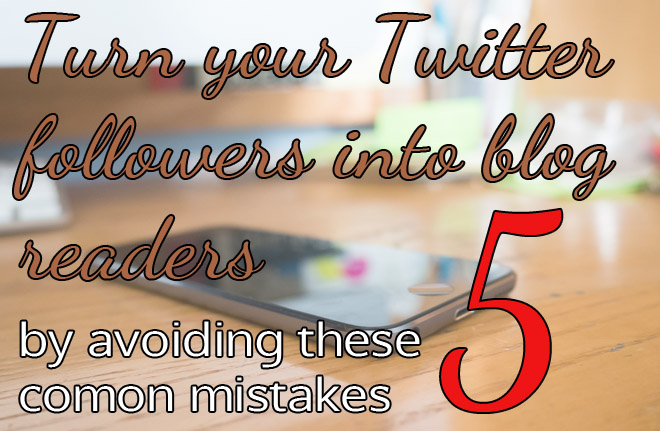
1. Sending Automated Direct Messages
There are a lot of instances where automation can save you a ton of time, but automated direct messages aren't a place where you should be investing your energy. The reason is this: sending an automated, direct message tells people that you don't think that they're worth your time to engage with.
If you send every new follower an automated direct message that says something like "Hey! Thanks for the follow, why don't you check out my blog at [yourbloghere].com!" you might think that you're being polite and conversational, but what you're actually doing is spamming them with your content. They've chosen to follow you for a reason (a funny tweet, mutual followers, something you wrote, etc) and an impersonal direct message says to them "I don't care enough to tweet at you directly in public, but please go support my work anyway."
If you want to say hello to every new follower (and that's totally fine!) then make a point to do so publicly, positively, and keep your self-promotion for other tweets.
2. Auto-Following Back
Contrary to what many Twitter users think, your Following vs Follower ratio doesn't have to be the same, and it's not rude to not follow someone who recently followed you if their profile and tweets don't match up with the sort of content you want to see and engage with on your feed.
For example, if you're a fashion blogger it might not be beneficial for you to fill your feed with tweets about NASCAR and pro-wrestling (that is, unless you're a fashion maven who is also into NASCAR and pro-wrestling, in which case, keep doing your thing!)
You can easily grow your audience by tailoring the people that you follow and interact with to fit your blogging goals.
Twitter isn't a competition, and the person following the most people doesn't win at social media - in fact, what it likely does is dilute their ability to engage with others and have real, meaningful conversations. Only follow back if you mean it.
3. Never Engaging with Your Followers
The most important thing to remember when using Twitter is that it is a social network first and foremost. This means that you have to interact with, share content from, and ask questions to the people you follow. Simply tweeting out into the void isn't going to bring anyone to your website; you have to engage with people and give them a reason to click through to your content.
On the flip side, a major downside to having a lot of Twitter followers is that it's virtually impossible to interact with every one of your followers. The best solution is to create lists and add your favourite Twitter users to them so that you can easily stay up-to-date with what they're tweeting.
4. Only Talking About Yourself
This is the worst mistake that bloggers (and anyone, really) can make on any social platform, but Twitter makes this habit much more obvious because your timeline looks so condensed on your page.
For instance, if I visit a person's Twitter profile and all I see are a series of tweets that are essentially "thought bubbles" (eg: "I love Big Macs!" "Today was going great until I got splashed by that bus," "nobody ever visits my blog") with no interaction with anyone else I'm not going to follow them because they're obviously not contributing to a larger community - they're just using Twitter as a soapbox.
Do not use Twitter as a soapbox. It's a social tool and is insanely effective for growing your audience and expanding your readership when used effectively, and that means spending the time to get to know the people in your online community - ask questions, share interesting posts, congratulate people on their successes!
5. Tagging People in Your Tweets
When you post a tweet with a link to a new blog post, it's only okay to tag someone in the body of your tweet if they are involved with the post somehow. For example, if you reviwed an album you can tag the artist in the tweet, or if you interviewed someone you can tag them to let them know you've posted their interview.
If you're simply tweeting at your followers and other random people about your content it's more likely that they will unfollow you than click through to your post. This is because you aren't providing them with a reason why they should click through to read, you're simply tagging them with the expectation that a simple mention is enough to pique their interest.
The trick to get people to read is to build your audience by engaging with your Twitter followers on a consistent basis and showing them why they should care about your blog. Your Tweets should show people that you're a super cool, funny and interesting person (because you are, obviously), and because your blog is a larger extension of that persona people will naturally want to see more of what you have to say than what you can express in 140 characters.
To Sum It All Up
You can't force people to start caring about what you have to say, but by engaging with them and showing them that you're an interesting, caring individual they will naturally make the jump from being Twitter followers to blog readers and even newsletter subscribers.
This will take time and a fair bit of effort, but in addition to new hits to your site you will also be developing a larger network of interesting people who you can engage with to help you grow and succeed in your endeavours.
Do you have anything to add to this list? Have you ever had a bad experience on Twitter? I'd love to hear about it!
